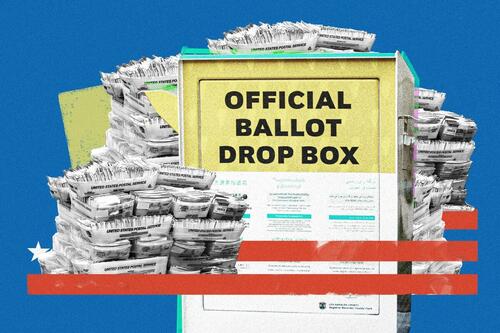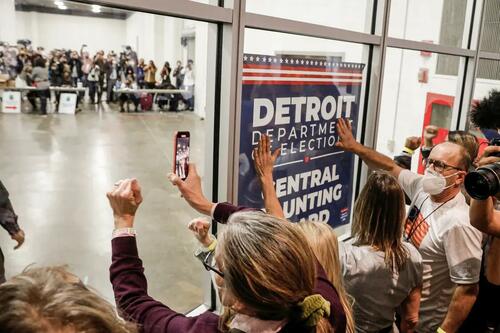Rise In Mail-In-Voting: A Convenience Or Pathway To Fraud?
Authored by Kevin Stocklin via The Epoch Times (emphasis ours),
As states gear up for highly consequential elections this fall, one of the most critical factors in the United States is the rise of mass mail-in voting.

According to the Census Bureau, 43 percent of American voters cast ballots by mail in 2020, double the 21 percent who did so in 2016.
While 2020 was an exceptional year because of the government’s response to the COVID-19 virus, the United States is nonetheless experiencing a longer-term transition to an absentee ballot system from an in-person system. Currently, California, Colorado, Hawaii, Nevada, Oregon, Utah, Vermont, Washington, and the District of Columbia have “mostly mail voting” systems, according to an analysis by the National Conference of State Legislatures (NCSL).
And while the 2020 election saw record levels of voter turnout, the shift away from traditional voting methods also coincides with a decline in trust in America’s electoral system. An October 2023 poll by the Public Affairs Council, found that only 37 percent of Americans believe the 2024 elections will be both “honest and open,” while 43 percent expressed “serious doubts” about election integrity.
This loss of trust raises the question of whether the problem stems from losing candidates charging that the elections were stolen from them, or from America transitioning to a system that prioritizes convenience from one that prioritized integrity.
Many pundits claim there is no tradeoff between the two and government officials, notably the Cybersecurity and Infrastructure Security Agency, called the 2020 election “the most secure in American history.”
However, a large number of Americans, particularly Republican and Independent voters, remain unconvinced.
The NCSL cautions that “if a voter is marking a ballot at home, and not in the presence of election officials, there may be more opportunity for coercion by family members or others.”
According to a recent NCSL study, 28 states, including the key swing states of Arizona, Georgia, Pennsylvania, Michigan, and Wisconsin, currently offer “no-excuse” absentee voting, which means that any voter can request and cast an absentee ballot without offering a reason.
In addition, California, Colorado, Hawaii, Nevada, Oregon, Utah, Vermont, and Washington, D.C., automatically mail absentee ballots to all voters.
In the remaining 15 states, voters must provide an acceptable excuse (such as illness or disability, or being overseas on Election Day) to qualify for an absentee ballot.
The Heritage Foundation, a conservative think tank that keeps a running tally of proven cases of voter fraud, has documented more than 1,500 cases to date and 1,276 criminal convictions.
“Each and every one of the cases in this database represents an instance in which a public official, usually a prosecutor, thought it serious enough to act upon it,” the report states. “And each and every one ended in a finding that the individual had engaged in wrongdoing in connection with an election hoping to affect its outcome—or that the results of an election were sufficiently in question and had to be overturned.”
According to Hans von Spakovsky, senior legal fellow at the Heritage Foundation, the numbers cited in the report are probably an understatement.
“The thing about these 1,500 cases is that they’re clearly just the tip of the iceberg because fraud is very hard to detect,” he told The Epoch Times. “A lot of times it’s just found by accident, particularly in a state like New York or California where there’s no voter ID requirement at all.”
Many of these cases cited in the report involved the fraudulent use of absentee ballots. In the case of one Michigan resident who was convicted of voter fraud, “an employee at an assisted living facility, completed roughly two dozen absentee voter applications, forging individual signatures of residents.”
However, the left-leaning Brennan Center for Justice, an affiliate of New York University, criticized what it said was the “myth of voter fraud.”
“Politicians at all levels of government have repeatedly, and falsely, claimed the 2016, 2018, and 2020 elections were marred by large numbers of people voting illegally,” the institute said in a report. “However, extensive research reveals that fraud is very rare, voter impersonation is virtually nonexistent, and many instances of alleged fraud are, in fact, mistakes by voters or administrators.
“The same is true for mail ballots, which are secure and essential to holding a safe election amid the coronavirus pandemic,” its report states.
In the manic weeks following the 2020 election, data analytics expert Ken Block, president of Simpatico Software Systems, was hired by the Trump campaign to data-mine for voter fraud in the key states of Georgia, Pennsylvania, Arizona, Nevada, Michigan, and Wisconsin, and find “factual, hard evidence that can underpin successful legal challenges.”
“It started with assessing the deceased voters and duplicate voters,” Mr. Block told The Epoch Times. “We looked at every single mail-in ballot cast in the swing states, looking for deceased voters.
”We found, in terms of actual deceased voters that we could confirm through data, a couple of dozen.”
Mr. Block said he found a small number of people who voted twice, typically wealthy individuals who had two residences, but the cases of detected fraud were not nearly enough to sway the election. He was also asked by the Trump campaign to investigate various “hearsay claims” of voter fraud.
“We looked at every single voter fraud claim, and I was able to show with evidence and proof why it was flawed, or just completely wrong in the first place, and those findings were accepted by [President Trump’s] lawyers,” he said. “I think it’s crucially important that everybody understands how hard we looked and how important it was, from a legal standpoint, that the claims of fraud that I evaluated were looked at as hard, if not harder than the defense attorneys who would be fending off these lawsuits.”
And yet, despite all efforts to assure the public that elections are sound, many Americans continue to suspect that something is amiss.
While some instances of voter fraud may be detectable in data and audits, others, such as whether voters are noncitizens, or engaging in ballot harvesting, or illicitly filling out ballots on behalf of others, are more difficult to detect unless witnessed in person or caught on camera.
A particular issue with mail-in ballots is the proliferation of ballot drop-off boxes since 2020, few of which are monitored.
According to Mollie Hemingway, editor-in-chief of The Federalist, and others who analyzed the 2020 election, the funding and locations of many ballot drop boxes in 2020 was directed by an organization called the Center for Tech and Civic Life, backed by hundreds of millions of dollars from Facebook founder Mark Zuckerberg.
Ms. Hemingway argued in her book, “Rigged,” that the donations from Mr. Zuckerberg, called “Zuck Bucks,” were partisan and focused on swing states.
The influence of private money in state electoral systems has only heightened the suspicions of many Americans.
A 2021 report from the Massachusetts Institute of Technology (MIT) Election Lab states that “even many scholars who argue that fraud is generally rare agree that fraud with VBM [vote-by-mail] voting seems to be more frequent than with in-person voting.
“There are two major features of VBM that raise these concerns,” the report states. “First, the ballot is cast outside the public eye, and thus the opportunities for coercion and voter impersonation are greater.
“Second, the transmission path for VBM ballots is not as secure as traditional in-person ballots. These concerns relate both to ballots being intercepted and ballots being requested without the voter’s permission.”
The report cites, among others, the case of a campaign manager in a North Carolina congressional race who collected empty mail-in ballots and then filled them in for his own candidate. Ultimately, that led to the election being overturned.
Read more here…
Tyler Durden
Fri, 02/23/2024 – 17:40
via ZeroHedge News https://ift.tt/qunwPKa Tyler Durden

